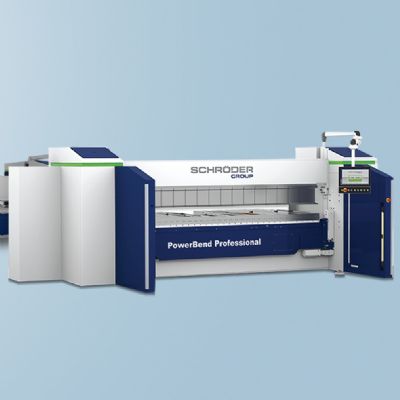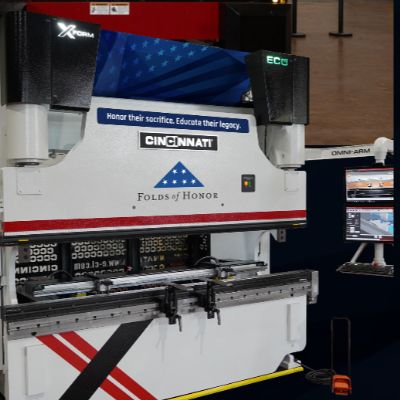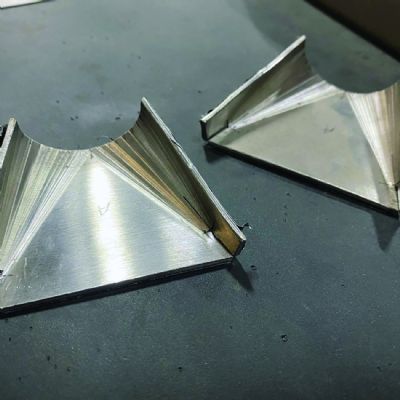Advancements in Fiber Lasers
Cutting Small, Medium & Large Profiles
When cutting with lasers, different size profiles may require multiple process parameters to be adjusted in real time to optimize cutting outcomes. Learn how the numerous process parameters have an impact on fiber-laser cutting.
Beam Delivery Solutions
Principles of laser-beam delivery and optics will be explained.
Advanced Applications of Multiaxis Solid-State Laser Systems
Learn about multiaxis laser cutting, welding and laser metal deposition applications.
Tuesday, November 13
8:00 a.m.–10:00 a.m.
Comparative Cutting
Laser Cutting
Review the basic capabilities and limitations of laser cutting and how the process compares to other options.
Waterjet Cutting
Learn about the latest in waterjet technology, applying waterjet technology to new applications and how to get the most out of your waterjet-cutting machine.
Plasma Cutting
Discover how new advancements in plasma plate cutting technology have increased pierce thickness, allowing plasma to replace oxyfuel in materials to 2 in. thick.
10:30 a.m.–12:30 p.m.
Advancements in Waterjet Cutting
Retrofitting Waterjet Cutting Systems for Flexibility
Learn how these systems can be retrofitted with a range of accessories such as rotary axes, angled cutting heads, special nozzles, vertical contour following systems and precision locators.
Increasing Waterjet Productivity with X-Stream Pressure Technology
Learn how 90-ksi X-Stream pressure waterjet technology can increase productivity by as much as 50 percent, while reducing operating costs by 40 percent.
1:30 p.m.–3:30 p.m.
Advancements in Plasma Cutting
Automated Plasma Bevel Cutting Technology: Process Challenges and How to Achieve Successful Outcomes
Many techniques are used to achieve beveled edges with systems ranging from simple grinding operations to cutting systems with articulating bevel heads to move the plasma torch.
Unlocking the Secret to Plasma Plate Productivity
Learn how to move beyond simply making parts with plasma and begin to utilize all the technology has to offer, including the economics of material handling and reducing scrap through effective part nesting.
Recent Technology Advancements in the Plasma Cutting of Stainless Steel
Recent improvements in plasma-cutting torches and systems have enhanced plasma’s capability when cutting stainless steel.
Wednesday, November 14
8:00 a.m.–10:00 a.m.
Industrial Applications in Laser
Laser Marking
High-power, high-brightness fiber-laser markers now are offered up to 100 W. This provides a tool to produce extreme marking speeds on copper and aluminum work, as well as on ferrous materials.
Hot-Wire Laser Cladding and Joining
Laser cladding technology provides metallurgical bonding with low heat input. This enables precise control of the molten zone with the assistance of an integrated filler-wire system.
Design for Laser Joining
Learn how the choice of laser type, component material selection, weld joint design, component part preparation and part fixturing all are critical to successful implementation of the laser-welding process.
Innovation and Emerging Laser Technology: The Critical Role of the Control
Decades of domain expertise are integrated into CNC functionality, delivering a powerful platform to develop versatile systems. Forming & Fabricating Track
Monday, November 12
8:00 a.m.–10:00 a.m.
Rollforming Fundamentals
Basic Roll Design
Learn basic rollforming-design principles that will help make designs more functional.
Fundamentals of Rollforming
Learn how to design and produce parts regardless of the material by understanding the typical rollforming process and what can be rollformed.
Reducing Costs through Innovative Sheetmetal Design
This presentation will change the a designer thinks about the entire part-design process by incorporating all the necessary operations, including laser cutting, punching, bending, laser and conventional welding.
Press Brake—Part Design and Forming
Fundamentals for Operators, Supervisors and Engineers
Too frequently a disconnect occurs between part design and the ability to successfully form the part to the specified tolerance. This presentation provides a basic understanding of press brakes and press-brake tooling.
10:30 a.m.–12:30 p.m.
General to Advanced Rollforming Concepts
Update Your New or Existing Rollforming Lines with In-Line Punching and Cutoff Solutions
Learn how to integrate your rollforming lines with cutoff and punching operations.
Rollform Tooling Setup and Troubleshooting
Learn the proper to install rollform tooling, make the necessary adjustments and troubleshoot problems.
1:30 p.m.–3:30 p.m.
What’s New in Press Brakes
The Other Side of Press Brake Automation
This presentation will turn everything you know about press-brake automation inside-out.
Hybrid and Electric Press Brake Technology
In addition to energy savings, learn how machine stability and part accuracy are significantly improved due to lower machine operating temperatures.
Sheetmetal Bending in the 21st Century
A look at how evolving technology and modern social priorities are driving the press brakes are designed and supported, from bending technology on your mobile phone to energy-efficient electric machines.
Estimating: Made To Order
Learn how to effectively estimate the costs for a job, and how to manage requests for quote, material needs, operation time and large assembly estimating.
Tuesday, November 13
8:00 a.m.–10:00 a.m.
Tooling Solutions for Metal Fabrication
Emerging Press Brake Tooling Technologies—New Products that Increase Productivity and Expand Flexibility
This presentation will focus on new press-brake tooling technologies and provide insight into what applications they are best suited for, to minimize costs and maximize productivity.
Cost-Savings Techniques for Sheetmetal Fabrication
Learn how to reduce costs throughout your sheetmetal-fabricating operation by increasing machine uptime, reducing secondary operations and improving setup and staging.
Metallurgy of Tooling Materials
Learn to recognize the factors that affect the performance of tooling materials, including the basics of grade selection, failure mechanisms and the treatments that can enhance performance.
Automated Deburring
Learn what type of deburring machine will work best for your operation to achieve optimal performance and obtain the best finish possible.
10:30 a.m.–12:30 p.m.
Effectively Slitting and Blanking Coils
Slitting to Achieve the Best Result
Learn how to produce quality slit edges while maximizing tooling life.
Precision Coil Slitting
Learn how you can make your slitting operation more efficient and productive while still processing quality product regardless of the material grade.
New State-of-the-Art Coil Slitting Technology
Achieve tighter tolerances and greater productivity on your slitting line with new innovations, such as CNC slitter-head control, slitter-head tooling setup and vacuum roll strip tensioning.
Advances in Blanking
A lot of confusion remains regarding blanking: What is the proper to measure blanks, what types of CTL/blanking lines are best suited to produce the most accurate parts, etc? This presentation will discuss common questions and misperceptions.
Plate Fabrication
Lifting Magnets—Choosing, Using and Benefitting
Understand the basics of magnetic material handling, everything from how magnets work and the differences between the various types of magnets to the potential applications for lifting magnets.
Plate-Rolling Fundamentals—How to Get the Job Done
Learn the basic principles of roll technique, material thickness variances and tips to help become more effective in rolling material.
Better Holes with Plasma: What You Need to Know to Take Hole Cutting to the Next Level
While many acknowledge the difficulties in using plasma for hole cutting, advancements in technology have enabled a to significantly improve hole quality while lowering operating costs.
1:30 p.m.–3:30 p.m.
Advancements in Leveling Technology
Changing Shape of Flat Rolled Metals
The secret to upgrading the flatness of flat rolled metals is to understand shape defects and basic metallurgy determining material behavior.
Laser-Quality Metals—How?
Learn how to process perfect laser-quality sheetmetal.
Beyond Coil—The Unique Challenges of Leveling
Flatter parts can reduce manufacturing time, lower product costs and produce parts with tighter tolerances. This presentation explains the options for leveling, flattening and straightening, and describes best practices.
New Innovations in Leveling
With the increased use of lasers, it is more important than ever that material is flat. Understand the latest technology available for measuring flatness.
Using Robotics in Metalforming and Fabrication
Getting Started with Robotics
Learn the pros and cons of introducing robots into your operation, and how to evaluate robotic equipment and suppliers.
Robotics—State of the Industry and Technology
Wednesday, November 14
8:00 a.m.–10:00 a.m.
Maximizing Your Press Brake
Maximizing Press Brake Productivity
Learn how the latest technologies available on the market can help maximize press brake productivity.
Double Your Output
This presentation will show you how to rethink the you form parts, by purchasing the right options on a press brake.
Stamping Track
Monday, November 12
8:00 a.m.–10:00 a.m.
Tool Steels to Improve Die Life
Use of Surface Engineered Pre-hard HRC 45 Tool Steel in Forming Applications
Learn the results of laboratory tests pertaining to the influence of die surface conditions on die adhesive wear when forming 0.95-mm thick DP 600 sheet.
A New Tool Steel for High-Toughness High-Wear Tools
PM-manufactured tool steels have traditionally offered higher wear resistance alternatives to D2, M2 and other conventional tool steels. This presentation will discuss the development and properties of a new grade, and relate its properties to failure modes and performance expectations.
Improving Business Results through Effective Cost Models and Training
Metalforming Pioneer: Development and Implementation of Press Operator Training Program
Listen as an award-winning company describes the development and application of an internally developed, comprehensive Automatic Press Operator Training Program and a new Technician Training Program.
Metalforming Pioneer: Inhouse Training|Cross-Training|Project Management
A metalformer describes its internal training program, emphasizing cross-training, training metrics and career paths.
Purchasing Practices and Trends in Utilizing “Should Be” Cost Models when Evaluating Stampings
This is an overview of the various s cost engineers/estimators develop “should-be” cost models, and how buyers use these models to analyze and benchmark supplier quotations.
10:30 a.m.–12:30 p.m.
Introduction to Formability Engineering and Analysis
An introduction to the Science of Formability analysis in the advanced-engineering and production areas of stamping. Participants will learn about the principles of formability analysis in the form of circle grid, as well as leading-edge computer simulations.
Case Studies—In-Die Sensor Applications and Growing Talent through Internships
Advanced In-Die Sensor Applications
A tutorial on the best practices for die protection and automated in-die part quality measurement. Learn about self-adjusting dies that compensate for material changes.
Metalforming Pioneer: An Internship Model
Hear how one metalformer developed a successful internship program working with a local high school, exposing students to careers in manufacturing and identifying potential employees.
1:30 p.m.–3:30 p.m.
Progressive Strip Layout and Stamping Estimating
Progressive Strip Layout
Reviewed are the major steps in the optimization of strip layouts using computerized tools, starting from planning the number of operations and ending with formability simulation using finite increment technology and incremental simulation technology.
Stamping Estimating
Reviews the elements of cost of producing automotive parts in progressive dies as compared to those made in transfer dies. The strategies for tooling costs will be reviewed and a unique technology for predicting and validating process plans will be presented.
Continuous Improvement, Safety, and World-Class Idea Cultures
Metalforming Pioneer: Developing an Effective Continuous-Improvement Culture
Learn how a metalformer built a continuous-improvement culture whereby employees take ownership of costs and improvements, reaping many benefits both to the company and its employees.
Metalforming Pioneer: Pioneering a Safety Culture
Listen as a metalformer discusses its “Safety Breeds Success” world-class safety program, which has resulted in increased performance and productivity, cost savings and a positive work environment.
Metalforming Pioneer: Employee Involvement—A World Class Idea Program
This award-winning stamper outlines a suggestion program that resulted in 7068 individual improvements in 2011, generating a significant cost savings.
Tuesday, November 13
8:00 a.m.–10:00 a.m.
Advances in Stamping Technology: Servo Drives and In-Die Fastening
Servo Drives and Forming Flexibility —Growing Your Production Mix
Application examples will be presented to demonstrate the increased flexibility and capacity that comes “off-the-shelf” with servo-drive presses, regardless of the press manufacturer. We’ll identify how different motor and drive configurations impact servo press performance and capacity.
This presentation focuses on the advantages of installing fasteners within the stamping process. Attendees will learn how to determine when an in-die system is appropriate, and how to properly evaluate a project.
10:30 a.m.–12:30 p.m.
Enhancing Quality Through Efficient Hole Punching and Springback Control
Improving Hole Quality and Tool Life in Thick Metals with Dual Head Punches
Learn how a dual head punch accomplishes punch and shear in a single press stroke at one position, creating a pierced hole to specifications along with an 85+ percent shear for each hole.
Springback: Recognizing and Reacting to Variation
The sources of springback will be discussed, as will process variation and process control, simulation of springback and appropriate countermeasures.
1:30 p.m.–3:30 p.m.
Stamping High Strength Steel in Progressive Dies
This presentation addresses problems specific to high-strength steels, including AHSS grades. Topics include press selection, die design, feeding and straightening, and selecting die steels for optimal tool life.
Wednesday, November 14
8:00 a.m.–10:00 a.m.
Improving Stamping Efficiencies through Measuring and Right-Sizing Equipment
Efficiency Improvements in the Stamping Shop
Manually collected production data can be inaccurate and biased, and often is available only when it is too late to correct a problem. This presentation describes automatic collection of production data directly from the press, including uptime, downtime, reasons for downtime and part counts.
Right-Sized Equipment for Lean Manufacturing
This presentation provides examples of setup-intensive processes and the complex production flows, massive inventories and other waste that can result from traditional batch and queue production methods. Featured will be examples of right-sized equipment to simplify production flow and eliminate waste.
10:30 a.m.–12:30 p.m.
Stamping Press Maintenance—Preventive and Planned Obsolescence
Planned Obsolescence—Critical for Today’s Press Maintenance
This presentation will cover preventive maintenance and its impact on productivity, and recommendations to reduce downtime risks with aging presses.
How To Design and Implement World-Class Preventive Maintenance in the Press Room
This presentation will help attendees begin the process of developing and implementing a PM program. MFIndustry-Related Terms: Bending,
Blanking,
Circle,
CNC (Computer Numerical Control),
Die,
Ferrous,
Form,
Forming,
Grinding,
LASER,
Lines,
Plate,
Scrap,
Stainless Steel,
Stroke,
Surface,
Thickness,
Tolerance,
TransferView Glossary of Metalforming Terms Technologies: Bending








